Bold Moves: Powerful strategies in a weak economy

When Boating Industry magazine launched its Movers & Shakers Recognition Program this summer, we were thrilled by the number of outstanding success stories we received from nominees.
While we could only name a few as Movers & Shakers, we couldn’t keep all the insights they shared to ourselves, so we created Bold Moves to highlight the powerful strategies the following leaders have employed to overcome the obstacles presented by the recession and achieve growth in today’s marketplace.
Together, they send a striking message about the strength of the marine industry and its leadership despite the extremely difficult business environment in which they have operated in recent years.
Coming full circle

Tom Mack | President/Owner
South Shore Marine | Huron, Ohio
Tom Mack was faced with the same series of economic challenges as every other marine operator back in August 2008. But rather than hit the panic button and take immediate measures to reduce costs, Mack managed the adversity while adhering to one of his key mandates to preserve excellent customer service.
Ultimately, the economic crisis did require South Shore Marine to downsize, reducing its staff by 20 percent. To make the best decision for his business, Mack conducted a close analysis of his team, careful not to cut key resources in his workforce.
“The one thing we tried to do was make sure the customer perceived it as business as usual with no interruption in quality of service,” says Mack. “It was a tough decision [to downsize], but it lowered expenses where needed.”
Once he made those cutbacks, he presented his team with a company-wide cost-reduction plan in which everyone would share in a 10-percent pay reduction for six months in lieu of additional layoffs.
To go along with those changes, Mack implemented effective personnel strategies. He put some of his departments “under a microscope,” moving people into positions where he could best leverage their strengths, and introducing initiatives to increase profitability in operations and service. A key initiative, he explains, was efficiency tracking, where each department began submitting daily performance reports. Those who were performing were rewarded, and those who “needed to step it up” were the next people to be taught or trained.
Within six months, Mack could see significant improvement. South Shore showed an impressive rise in revenue growth from both its service department and its pre-owned boat segment. In fact, over the course of just one year, the company’s service revenue grew by nearly 20 percent — a fact that convinced Mack that his company was leaving money on the table prior to 2008.
“We made a really strong initiative in our service department by ‘doing the job right the first time’ and having the right leadership,” Mack explains. “We kept it very simple. We tracked and recorded progress on our service initiatives in writing. It’s interesting when an employee’s or department’s successes or troubles are presented on paper and placed on the wall for everyone to see. It’s surprising to see motivation increase.”
Perhaps most significant among Mack’s moves was how his personnel decisions came full circle. His team responded to the new initiatives and performed so well that Mack not only reinstated his employees’ full salary, but he also reimbursed them over a year later, unexpectedly, for the pay cut they took while times were tough. In addition, he was able to hire employees to fill the positions he had cut in the early days of the recession.
“During a time when the marine industry has seen some of the most devastating losses, both in revenue and jobs, Tom Mack has been able to take his company and do the exact opposite,” explains the trio of South Shore employees who nominated him. “Tom was able to pick up what he had, make a clear plan of attack and trudge through the storm. While others around us have fallen down or been washed away in the storm waters, Tom not only made it through to safety, but was able to grow and take on more as he did it.”
Seeing beyond the recession
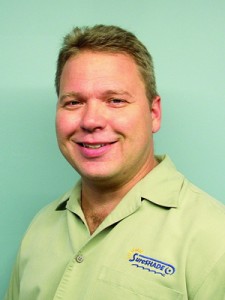
Ron Russikoff | Founder
SureShade | Philadelphia, Pa.
Ron Russikoff was just getting his feet on the ground in 2008 when the marine industry was pummeled with the credit crunch and the beginning of the worst downturn boat sales had ever experienced. It certainly wasn’t the best time for a start-up in any business, let alone in an industry that was about to be hit so hard.
But Russikoff attacked the difficult situation head-on, employing defined strategies and making a series of key decisions to bring SureShade, his retractable sun-shade system, to market. Russikoff reflects on numerous strategies that helped his company stay afloat, but none of them was as critical as his plan to penetrate the boat builder market.
After the initial introduction of the system at the 2007 International BoatBuilders Exhibition & Conference, Russikoff established the right relationship, and the rest, as they say, is history.
For nearly 10 months, Russikoff and SureShade collaborated with Boston Whaler, working within the boat builder’s production timeline to incorporate the design of the first commercially produced system for the Whaler 370 Outrage. And in early 2009, showcased aboard that boat, the system had a successful launch at the Miami International Boat Show.
“Rather than retreat and wait for things to get better, it was all about getting to one boat builder,” says Russikoff. “It was about getting one OEM in place. The OEM had to be extremely visionary, one that could see beyond what was going on at the time and be able to look into the future.”
Russikoff’s efforts resulted in tremendous performance for both his company and for Boston Whaler.
Since 2009, SureShade has more than doubled in growth, year after year, and its market share is on the rise, as well, says Russikoff.
“How we continue to grow and how we continue to gain the exposure in the market to let people know that we are here to stay, we go day by day,” he comments. “And if that means going into our own pockets to do that, we are happy to do so, as we know that in time there will be a significant return on our investment.”
Boston Whaler says that 75 percent of its 370 buyers choose the company’s motorized, retractable canvas cover system as an option. “The response was so great that we are now offering their newest SureShade mechanical system on our 2012 285CQ,” explains Jeff Stern, buyer/planner at Boston Whaler.
Boat sales take a backseat
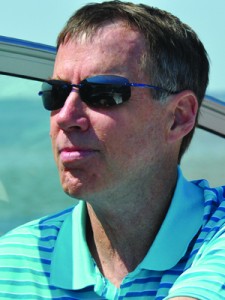
Fred Pace | Managing Partner
Legendary Marine | Destin, Fla.
No marine business escaped the recession unscathed. For most, the downturn meant a 30-percent drop in new boat sales, threateningly high inventory levels, a reduction in staffing, and a strategy shift that focused solely on survival.
For Fred Pace and his team of employees at Legendary Marine, it was much worse. The steepness of the downturn really began to take hold in late 2008.
Then, in June of the following year, one of the dealership’s major suppliers, Genmar, filed for bankruptcy. Finally, less than a year later, the BP oil spill ravaged the Gulf Coast boating market, including Legendary with its four locations along the Florida Panhandle.
But through a series of strategic moves, Pace and his team fended off these challenges and forged a path toward success. While you can read the full story about “Legendary Resiliency” at BoatingIndustry.com, to summarize, Pace brought on a host of new team leaders and began aggressively pursuing alternative profit centers.
“We really had to look at how to do business differently,” says Pace. “We had to look at things that might provide additional revenue sources.”
It began with advertising and marketing strategies designed to promote its current revenue center: boat sales. This included playing host to more than 30 special events and activities throughout the core selling season.
Then, Pace put forth a simple plan to complement sales with aggressive service tactics, which exploded into a series of recession-busting efforts that helped to solidify Legendary’s future.
Pace and his managers began targeting customers in its two dry storage facilities with free comprehensive inspections, and almost half of the customers took them up on the ensuing recommendations. The process – employed by other leading marine service businesses – helped Legendary level out the troughs and valleys of the off-season, while driving revenue for the company when it needed it the most.
What’s more is that the inspections and service reports also became a catalyst for additional sales going forward, oftentimes from customers who had bought previous boats from other dealers.
At its Destin location alone, Pace reported a 23-percent increase in service business in 2010 over 2009, and the company is outpacing that year-over-year increase in 2011. Its Panama City location is up 15 percent in parts and service, and Legendary Marine’s Gulf Shore location reported a 20-percent increase in service.
“The downturn and subsequent change in the marine environment has taught us that we need service to be the mainstay of our business,” says Pace. “The selling of new, pre-owned or consigned boats is an additional profit center, but it’s not the number one profit center.”
Now that is a new approach to the marine business.
Investing in quality
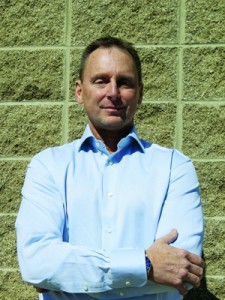
Steve Vogel | CEO
Bennington Marine | Elkhart, Ind.
If there’s one sector of the boating market that has fared better than the others during the downturn, it’s the pontoon market. But not all companies in this space have benefited equally.
Take Bennington Marine, for instance. Under the bold leadership of CEO Steve Vogel, the company has experienced strong year-over-year unit sales increases, which have contributed to significant growth in market share.
It began with a goal set by Vogel in August 2008 to spur consumer interest by offering more value. This resulted in an 18-month plan to redesign the Bennington product line-up with improved styling and aesthetics. Simultaneously, the company simplified its purchasing and manufacturing by eliminating certain SKUs.
Even more outstanding, however, was Vogel’s decision amidst the great challenges of the downturn to eliminate the use of “entry level materials” in favor of more expensive materials, an effort designed to take Bennington’s product quality to a new level.
“If you look at it from a financial standpoint, the costs go up,” says Vogel, “but in the end, we did the right thing in the way we design our product.”
The strategy worked. Bennington sold more product and made more money.
“We knew in August/September of 2009 that 2010 was going to be a good year for us,” Vogel explains, “not because the market was going to turn around, but because we knew we would start gaining share and we did.”
In fact, in its first year with the product redesign, Bennington’s share went from 11 percent to approximately 15 to 16 percent, according to Vogel. And in 2011, the company continued to work on product redesigns, price points and distribution, gaining further share of the market. As of the first quarter of 2011, Bennington held 21 percent of the pontoon market.
Today, while profits are not where they were five or six years ago, the company is staying competitive and continuing to grow, says Vogel. Bennington expects to have a total model output of 6,500 units in 2011 and an estimated 7,500 in 2012.
“Business is a lot tougher,” Vogel comments. “We had to be more competitive and we had to figure out other ways to make money. It wasn’t just going to be you put this material in, add a margin and sell it. You have to be more creative than that today.”
Swimming against the tide
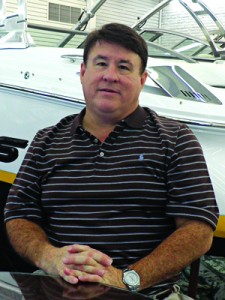
Mike Tutor | Owner
Marine Sales of Pickwick | Counce, Tenn.
While most entrepreneurs wouldn’t risk investing in a marine business during a downturn, Mike Tutor did exactly that. But he didn’t just buy a dealership. He took it to a whole new level.
Tutor purchased Marine Sales of Pickwick in 2007, and with an investment of approximately $800,000 (excluding inventory), he set out to refurbish the dealership by increasing its boat storage capacity, establishing an in-water boat display area, and redesigning its showroom. He even installed air conditioning to make his customers more comfortable when browsing.
“As people saw two or three other dealers closing their doors in the area, they saw us investing in the business,” says Tutor. “That gave our customers a better sense that we were not giving up or going anywhere, and we were there to support them.”
In a further effort to support these initiatives, Tutor worked closely with General Manager Ron Martin to ramp up boat sales by adding Sea Ray and Meridian to the existing boat lines: Cobalt and Crest Pontoons. With an impressive stable of boats, they hired a young, keen sales staff and added an on-water location to better showcase the models. The dealership was in a fortunate position to already have a strong existing service and accessory department.
By setting business goals for employees in the sales, service and retail departments and establishing an employee compensation plan based on a percentage of increased revenue, Tutor built a team that had his same focus on driving sales and boosting customer service.
“If you provide ownership to employees without having actual ownership, and giving them the opportunity to see a direct result of their efforts going right into their pocket, there will be results,” he says.
And he has seen results. By the end of the first quarter of 2011, the dealership had driven the Cobalt brand to a 71-percent market share, twice the national average of share for Cobalt at 35 percent. In addition, the dealership’s revenue growth in the service and accessory departments climbed by more than 20 percent. Finally, total revenue grew more than 20 percent in 2010 and in 2011, with increased consumer traffic and Cobalt, Sea Ray, and Meridian boat sales.
“Our position in the area has improved greatly,” says Tutor. “ … But you always have to serve your customer and be able to sell a great product and make money at it. We’re achieving that.”
Making cash king
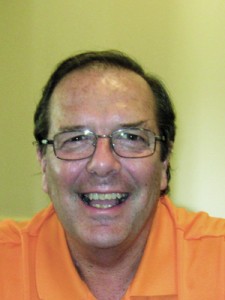
Doug Smoker | President
Smoker Craft Boats | New Paris, Ind.
In the past few years, most manufacturers have been forced to re-evaluate their strategies and product line-up in order to adjust to today’s market. But few have done it as effectively as Doug Smoker of Smoker Craft Boats.
Following a thorough analysis of internal operations, Smoker and his team were able to take steps to improve the company’s bottom line while maintaining its product quality and customer focus.
One of the first goals established by Smoker was to improve inventory turns. Under his leadership, the company decreased its aluminum pontoon and fiberglass input time, taking five to 10 days off the prior average time.
He also set out to increase Smoker Craft’s raw material turns. As of this past June, they were averaging approximately nine turns a year with expectations of reaching 12 turns. That compares to 2.5 to 3 turns in 2007 and 2008.
“We worked on increasing our efficiency and looked at how much total labor we used versus how much we actually produced,” says Smoker. “Our goal was to improve that number by six percent. So, if we were at 87-percent efficiency, we wanted a 93-percent efficiency. Through our internal programs, we accomplished that goal.”
To further improve efficiency, Smoker crafted a strategy to reduce the manufacturer’s number of models, trimming slower moving models in its pontoon, aluminum and fiberglass categories.
“We reduced our models by 50 percent and took our inventory down from a high point in 2009 to 60 percent, turning that inventory into cash that resulted in a much stronger cash position,” says Smoker. “There were significant savings. We have not borrowed money. We have been working on our own working capitol and have no long-term debt and no short-term debt. That is the significant savings we have seen.”
Meanwhile, Smoker introduced new key people to his team in an effort to reinforce Smoker Craft’s customer service and R&D. What transpired was all new styling in its pontoon line, new systems in its pontoons, and cleaner, functional enhancements to the interiors.
“The real goal for us is to continue to grow our business, to make the right pontoons for the market that are built properly with good quality, and to make a profit so we continue to reinvest in R&D and continue to improve product,” says Smoker.
That strategy seems to be working. In 2010, Smoker Craft was 40 percent ahead of 2009, and in 2011, it is running about 22 percent ahead of 2010 with expectations it will increase that percentage by the end of the year.
Web wisdom
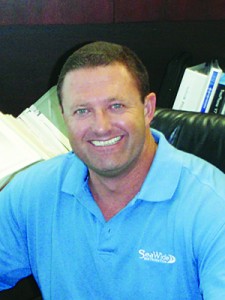
Mike Yarbro | President
SeaWide Distribution | Murietta, Calif.
f there’s any area that has seen an industry-wide increase in investments of time and money during the downturn, it’s the Web.
So when Mike Yarbro had the vision to launch a SeaWide Distribution B2B site in 2009, he put his company on track for success in tough times. And, in just the last year, SeaWide has seen tremendous online sales growth.
“Our increase in sales on our website has taken up online transactions by 40 to 50 percent in the past year,” says Mike Yarbro, president of SeaWide Distribution.
“Our business has grown at a steady pace and obviously any growth right now is good.”
It’s all about providing the flexibility and level of service to make it easier for customers to do business, according to Yarbro. To do this, the company broadened its inventory, began allowing customers to choose product from multiple locations, offered 24/7 access to SeaWide’s inventory, introduced pricing specials, and gave customers around-the-clock access to their account information including credit and invoicing data. Two flat-rate shipping programs are also offered: an overnight rate and a ground rate, both offered at reasonable shipping costs from SeaWide’s three locations in Seattle, Wash.; Sarasota, Fla.; and Murrieta, Calif.
“For fulfillment purposes, the dealer, especially in these times, doesn’t want to be blindsided when they order something,” says Yarbro. “Now, they know exactly what it’s going to cost when it lands on their door. It comes down to service, product availability and convenience.”
So far, feedback from SeaWide’s B2B site has been positive from its customer base. One service that has received particular attention is its product selection information, which includes imagery, specifications, availability and the various parts that are required for the product.
“With each order, our customer goes through a salesperson, and they go through an order to make sure the customer has everything they need,” explains Yarbro. “When they get an order, the customer wants to get to the boat and install it.
When they have to do it two or three times to wait to have the right pieces, it costs them money. It’s important for us to get them everything they need right from the start.”
Through the new website, Yarbro and SeaWide have made inroads into the world of online distribution and placed the company in a positive position in the marine marketplace, not an easy task in current conditions.
“It has helped us through the downturn,” says Yarbro. “It gave us a stronger channel to market our product. It has brought in a lot more of a customer base. A lot of businesses [we work with] say, ‘Now you have a B2B site, now it’s worth doing business with you’.”
From vendor to partner
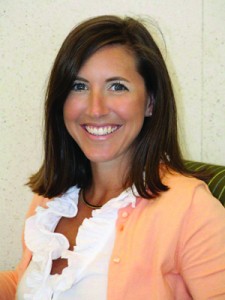
Courtney Chalmers | Marketing Director
Dominion Marine Media | Norfolk, Va.
When the downturn hit in 2009, the marine industry needed all the help it could get to adjust to the changing marketplace.
As part of Dominion Marine Media’s strategy for adapting, Courtney Chalmers, marketing director, has reached out to dealers and brokers to help them be more successful amidst the challenging conditions.
With the development of Get Online Leads Faster (GOLF) and through her efforts to enhance the Yacht Brokerage Universities (YBU) program, Chalmers has become a strong advocate of dealer and broker education.
“As the economy shifted and dealers were forced to reduce expenses and resources, we believed it was our job to help them get the most out of their business as they could,” says Chalmers.
To assist dealers in improving their Web presence, Chalmers developed GOLF, an online best practices marketing program devised to guide dealers through website design and help drive traffic. The program provides instruction in how to convert traffic to leads and navigation, SEO, e-mail campaigns, virtual merchandising and business intelligence.
Through this initiative, Dominion has become more of a partner to the dealer, rather than just a vendor.
“In taking it to 20 groups, dealer meetings, trade shows and industry events, dealers began to see that it wasn’t as difficult as they thought it would be,” says Chalmers. “One thing we did find is the dealers that used business intelligence and data to help make their business and marketing decisions were the ones that survived and even thrived in the downturn.”
Through Chalmers’ efforts to refine YachtWorld.com’s Yacht Brokerage Universities (YBU), the program has become more interactive, offering panel discussions that feature brokers and principals sharing best practices in business and marketing, as well as industry expert panels, which feature a series of representatives from various segments of the marine industry.
With these new offerings on the agenda, the 2010 YBU in Ft. Lauderdale and the 2011 Annapolis and Providence YBUs touted record-breaking attendance.
“We launched the new agenda at the Ft. Lauderdale YBU last year,” comments Chalmers, “and it was a real success to have so many brokers talking and sharing ideas.”




